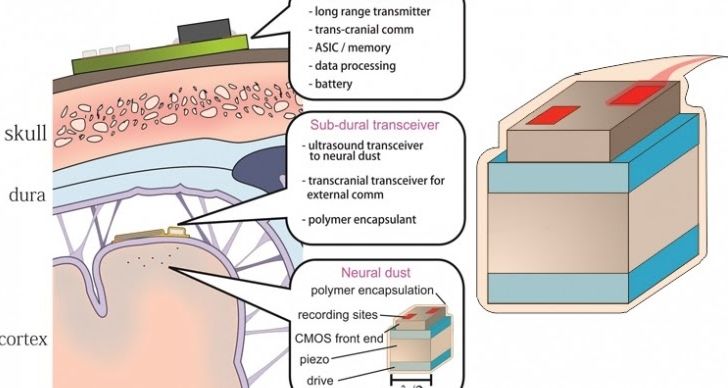Archive for the ‘neuroscience’ category: Page 955
Jun 6, 2016
Chronic stroke patients safely recover after injection of human stem cells
Posted by Sean Brazell in categories: biotech/medical, neuroscience
Injecting specially prepared human adult stem cells directly into the brains of chronic stroke patients proved safe and effective in restoring motor (muscle) function in a small clinical trial led by Stanford University School of Medicine investigators.
The 18 patients had suffered their first and only stroke between six months and three years before receiving the injections, which involved drilling a small hole through their skulls.
For most patients, at least a full year had passed since their stroke — well past the time when further recovery might be hoped for. In each case, the stroke had taken place beneath the brain’s outermost layer, or cortex, and had severely affected motor function. “Some patients couldn’t walk,” Steinberg said. “Others couldn’t move their arm.”
Continue reading “Chronic stroke patients safely recover after injection of human stem cells” »
Jun 5, 2016
The weird future: Elon Musk, Jeff Bezos offer up extraordinary visions of the impact of technology
Posted by Karen Hurst in categories: climatology, cyborgs, Elon Musk, neuroscience, robotics/AI, singularity, space travel
Musk concerns over Singularity/ cyborgs technology.
We are said to be headed towards a wired future. But that could equally be a weird future, going by what some tech entrepreneurs and artificial intelligence visionaries are saying about it. It’s going to get a lot weirder than self-driving smart cars. Elon Musk, who co-founded Paypal and started the Tesla electric car company – and thus has a track record of delivering on ambitious projects – also set up the SpaceX company, whose ultimate goal is to colonise Mars. He’s just announced, at this year’s Code Conference in Los Angeles, plans to send the first manned mission to Mars as early as 2024. Moreover cargo flights to Mars are also planned every two years, keeping in mind that a habitation on Mars will require regular supplies from earth.
Musk says he’s doing this to preserve humanity, since possibilities of a calamitous event that destroys human civilisation on earth – thanks to runaway advances in technology – are high. Perhaps we have a foretaste of this already when the Louvre museum packs up its treasures of human art and locks its doors due to floods in Paris, an event that has been linked to the pumping of greenhouse gases into the air that disrupt the earth’s climate. Amazon CEO Jeff Bezos comes at the same issue from the opposite end. He says heavy industry is too polluting and will need to be relocated to outer space to preserve the earth.
Jun 3, 2016
New Brain Implant Lets You Control Machines Using Your Thoughts
Posted by Shailesh Prasad in categories: biotech/medical, neuroscience
Australian scientists are developing a biocompatible implant that will allow paralyzed patients to control machines with just their thoughts.
Forget Siri and Cortana. Soon, you may be able to give commands to machines just by “thinking” them.
A team of researchers and engineers at Melbourne University are developing a stentrode, a tiny implant to be placed into a blood vessel next to the brain, which can record electric activity from a specific part of the brain. The information will then be decoded and interpreted into thoughts.
Continue reading “New Brain Implant Lets You Control Machines Using Your Thoughts” »
Jun 3, 2016
Entrepreneur and CEO Martine Rothblatt thinks we’ll 3D print new bodies and live forever on the internet
Posted by Shailesh Prasad in categories: 3D printing, education, habitats, law, life extension, media & arts, neuroscience, robotics/AI
When you think about the headliners at a music festival, it’s unlikely that the first person to pop into your head would be Martine Rothblatt—the founder of Sirius XM, the one-time highest-paid female CEO in the world who made a robot clone of her wife, and the founder of the Terasem religion, which believes we’ll live forever by uploading our consciousness to the cloud. But Moogfest, a four-day citywide festival of music and technology in Durham, North Carolina, was not the average music festival. Unlike other festivals that make cursory overtures to technology, Moogfest dedicated as much time to explaining how technology influences creativity as to the creative output itself, even listing headline ‘technologists’ alongside its top-billed musical acts.
On the festival’s second day, Friday 20 May, Rothblatt took the stage to talk to a packed house at Durham’s Carolina Theater, in an atmosphere that felt far more like a TED talk than a music fest. Rothblatt, who is transgender, discussed the contentious North Carolina HB2 law, which bans transgender people from using public bathrooms of the gender they identify with; the idea that creativity would be better encouraged by free college tuition; and how she got to a point where she and her company, United Therapeutics, can actually think about 3D printing new body parts, and leaving our bodies behind—if we want. “You want to win more than you want to live,” she told the rapt crowd. “You yell ‘Geronimo’ as you jump crazily into monopolistic opposition.”
Quartz sat down with Rothblatt after her talk to chat more about her thoughts on AI, living forever, free education, and what happens to the soul once we’ve made digital copies of ourselves.
Jun 3, 2016
New CRISPR system for targeting RNA
Posted by Shailesh Prasad in categories: biotech/medical, neuroscience
The new approach has the potential to open a powerful avenue in cellular manipulation. Whereas DNA editing makes permanent changes to the genome of a cell, the CRISPR-based RNA-targeting approach may allow researchers to make temporary changes that can be adjusted up or down, and with greater specificity and functionality than existing methods for RNA interference.
In a study published today in Science, Feng Zhang and colleagues at the Broad Institute and the McGovern Institute for Brain Research at MIT, along with co-authors Eugene Koonin and his colleagues at the NIH, and Konstantin Severinov of Rutgers University-New Brunswick and Skoltech, report the identification and functional characterization of C2c2, an RNA-guided enzyme capable of targeting and degrading RNA.
The findings reveal that C2c2—the first naturally-occurring CRISPR system that targets only RNA to have been identified, discovered by this collaborative group in October 2015—helps protect bacteria against viral infection. They demonstrate that C2c2 can be programmed to cleave particular RNA sequences in bacterial cells, which would make it an important addition to the molecular biology toolbox.
Jun 2, 2016
Neural Dust — ultra small brain interfaces — is being used to make cyborg insects
Posted by Klaus Baldauf in categories: cyborgs, electronics, energy, neuroscience
As the computation and communication circuits we build radically miniaturize (i.e. become so low power that 1 picoJoule is sufficient to bang out a bit of information over a wireless transceiver; become so small that 500 square microns of thinned CMOS can hold a reasonable sensor front-end and digital engine), the barrier to introducing these types of interfaces into organisms will get pretty low. Put another way, the rapid pace of computation and communication miniaturization is swiftly blurring the line between the technological base that created us and the technological based we’ve created. Michel Maharbiz, University of California, Berkeley, is giving an overview (june 16, 2016) of recent work in his lab that touches on this concern. Most of the talk will cover their ongoing exploration of the remote control of insects in free flight via implantable radio-equipped miniature neural stimulating systems.; recent results with neural interfaces and extreme miniaturization directions will be discussed. If time permits, he will show recent results building extremely small neural interfaces they call “neural dust,” work done in collaboration with the Carmena, Alon and Rabaey labs.
Radical miniaturization has created the ability to introduce a synthetic neural interface into a complex, multicellular organism, as exemplified by the creation of a “cyborg insect.”
“The rapid pace of computation and communication miniaturization is swiftly blurring the line between technological base we’ve created and the technological base that created us,” explained Dr. Maharbiz. “These combined trends of extreme miniaturization and advanced neural interfaces have enabled us to explore the remote control of insects in free flight via implantable radio-equipped miniature neural stimulating systems.”
Jun 1, 2016
Can A Brain-Machine Interface Help Train Your Mind?
Posted by Dan Faggella in categories: neuroscience, wearables
Walk into any workout facility and, odds are, you’ll see plenty of people working with a personal fitness trainer. It’s common practice to hire a trainer who can help improve your physical fitness, but is it possible to find a trainer for better mental fitness? Entrepreneur Ariel Garten founded her company, InteraXon, around this very idea. Bolstered by new advances in non-invasive brain-machine interfaces (BMIs) that can help people practice ways to reduce stress and improve cognitive abilities, Garten believes this is just the beginning of a lucrative industry.
Garten’s company manufactures a BMI called the Muse, an EEG sensor headband that monitors occipital and temporal brain waves. According to Ariel, the goal of the device is to help people understand their mental processes while at the same time learning to calm and quiet their mind at any time, with the same convenience of carrying around an iPhone.

Image credit: www.choosemuse.com
“We don’t measure stress (with the Muse). What we’re actually measuring is a state of stable, focused attention,” Garten said. “When you hone your mind into a state of stable focused attention, what you’re able to do is resist the thoughts that you have and the distractions that you have. That helps you improve your cognitive function and attention. And, it also helps you decrease your stress, anxiety and all of the downstream physiological responses of that stress.”
Continue reading “Can A Brain-Machine Interface Help Train Your Mind?” »
Jun 1, 2016
DARPA Sees US Fighter Jets as First Thought-controlled Weapon
Posted by Karen Hurst in categories: biotech/medical, cyborgs, military, neuroscience
Imagine these fighter jets being equipped with the DARPA death laser that is being worked on. Very deadly mix.
The size of a matchstick, the stentrode can provide the “brain-machine interface” or BMI necessary for thought-controlled devices. Neural implants currently in use require invasive surgery.
Stentrodes can be attached to the brain using catheter angiography. This procedure passes the device through blood vessels in the neck and into the brain without cutting open the skull.
Continue reading “DARPA Sees US Fighter Jets as First Thought-controlled Weapon” »
May 31, 2016
Can 3D printing brain tumours help fight cancer?
Posted by Karen Hurst in categories: 3D printing, biotech/medical, neuroscience

Good question.
Tiny balls of cancerous cells are being printed off by researchers at Heriot Watt University in Edinburgh who hope it can provide new ways of testing drugs and studying brain cancers.
Continue reading “Can 3D printing brain tumours help fight cancer?” »















